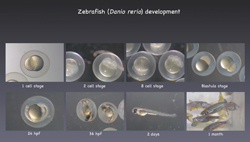|
by Dawn Brazell
Public Relations
Talk about a protein shake.
Researcher Philip H. Howe, Ph.D.,
points to a blender full of a
protein-rich shrimp mix that he
feeds his zebrafish. These rock
stars of research are upstaging
more traditional animal models
that have been used. He keeps them
healthy and well, given how they
can advance cancer treatment,
particularly in discovering how
metastatic cancer progresses in
humans.
Howe, who holds the Hans and
Helen Koebig Chair for Clinical
Oncology, said they are ideal for
researchers studying the process
of metastasis, especially since
zebrafish embryos are completely
transparent, making them ideally
suited for studying developmental
processes as they occur.
 Dr. Philip H. Howe
conducts zebrafish research in
his laboratory in the Hollings
Cancer Center. Dr. Philip H. Howe
conducts zebrafish research in
his laboratory in the Hollings
Cancer Center.
The highly fertile fish, which
even have their own website called
the Zebrafish Information Network
or ZFIN for short (http://zfin.org/),
live about two years, with a pair
of fish producing about 300
embryos in one week. The fish
become full-grown in two days. A
mouse, in comparison, would take
21 days.
Certain cancer cells are more
aggressive in proliferating,
similar to what happens in the
embryonic development process when
cells differentiate to form the
tissue and organs of the body, he
said. "Ninety percent of all
cancer deaths are caused by the
metastatic phase of the disease,
where cells escape from the
primary tumor and establish
secondary tumors at multiple sites
and organs. Our research is
focused on the process of
metastasis."
Most anti-cancer drugs take
advantage of how cancer cells grow
faster than normal cells,
targeting the mechanism behind
these proliferating cells. The
modern view of cancer in the past
10 to 15 years is that it's an
inappropriate reactivation of the
normal, developmental processes,
he said.
"Sometimes the cell forgets it's
old and is supposed to be
specialized, and it reverts back
to this embryonic stage. Tumors
can be viewed as corrupt forms of
normal developmental processes.
Most of the time the culprit genes
and proteins that are implicated
in these cancers also are found to
be important during development."
Beyond the rapid embryonic growth
and transparent eggs that make
them popular research subjects,
there also are economic benefits.
"It's much cheaper. This is a
tenth of the cost of a mouse
model. If you find something here,
the next phase would be to go to a
mouse model where you would
validate your target."
As with the mouse model, the
zebrafish genome has been
sequenced. The vertebrate species
has been found to develop almost
any tumor type found in humans.
It's another reason he got
involved with zebrafish research
about five years ago.
"It allows you to look at the
pathways more specifically than
the mouse model because of the
transparency and because you can
directly manipulate the fertilized
egg. If you manipulate a
fertilized egg with a mouse, then
you have to re-implant it into the
female. With zebrafish, it's all
done externally."
Researchers can take eggs at the
one-cell stage right after
fertilization, and inject genes,
knockout genes or over-expressed
genes, and look at the effect of
that on the development of the
fish. "It's a really good model to
study developmental processes and
take what we learn and go back to
cancer lines to analyze if those
have become reactivated in certain
cancers or not."
Another advantage to zebrafish
research is that the eggs are
permeable, allowing for
large-scale drug screens. "You can
breed animals so that they develop
melanomas, for example. Then you
can screen small molecule
compounds or plant extracts or
drug extracts to try to find out
which ones might be beneficial. It
allows for rapid, large-scale
screening for a permeable drug or
small-molecule compounds."
Given that researchers with the
National Institutes of Health and
chemical companies are going
worldwide to isolate compounds
from everything from exotic tree
bark to sea bacteria, zebrafish
offer a way to rapidly screen the
libraries of chemical compounds
being collected, which is
exciting, he said.
 Researchers inject
embryos at the single cell
stage, right after they are
fertilized. Howe said timing is
critical. They have to collect
the eggs and microinject them
within 15 minutes given the rate
of embryonic growth of
zebrafish. Researchers inject
embryos at the single cell
stage, right after they are
fertilized. Howe said timing is
critical. They have to collect
the eggs and microinject them
within 15 minutes given the rate
of embryonic growth of
zebrafish.
An area of success in Howe's lab
is in the study of a signaling
pathway called the Wnt pathway,
which is found to be abnormal in
breast cancer, colon and a variety
of hematological tumors. They have
found the Wnt pathway regulates
the growth of the last portion of
the tail in the zebrafish, with
researchers isolating a protein
that blocks the pathway. "If we
knock out the receptor that is
responsible for this development,
we can get a phenotype where we
get no tail. We can rescue that
phenotype with a human version of
the protein that's not targeted by
our protein."
Other exciting research, although
it didn't involve zebrafish, is
that his lab was the first to show
results in 2010-2011 about TGF
beta and how it can induce
metastasis through a translational
mechanism, RNA to protein, and not
transcriptional from DNA to RNA.
"This is a paradigm-shifting
model," he said about one of his
accomplishments. Other
laboratories worldwide now also
are working on this research area.
Howe, who is associate director
of basic science for the Hollings
Cancer Center, holds a number of
prestigious grants from the
National Cancer Institute and has
been continually funded for 20
years. His hope is that research
in his lab will help lead to
promising cancer treatments.
Thinking back to when his
interest in basic science began,
Howe said his father isn't
surprised about the work he's
doing.
"They would give me toys, and I'd
break them apart to see how they
would work. We're breaking down
cells using zebrafish to see how
they work. There's a beauty in
seeing how this stuff works. This
can lead to all kinds of
discoveries."
|



 Dr. Philip H. Howe
conducts zebrafish research in
his laboratory in the Hollings
Cancer Center.
Dr. Philip H. Howe
conducts zebrafish research in
his laboratory in the Hollings
Cancer Center. Researchers inject
embryos at the single cell
stage, right after they are
fertilized. Howe said timing is
critical. They have to collect
the eggs and microinject them
within 15 minutes given the rate
of embryonic growth of
zebrafish.
Researchers inject
embryos at the single cell
stage, right after they are
fertilized. Howe said timing is
critical. They have to collect
the eggs and microinject them
within 15 minutes given the rate
of embryonic growth of
zebrafish.